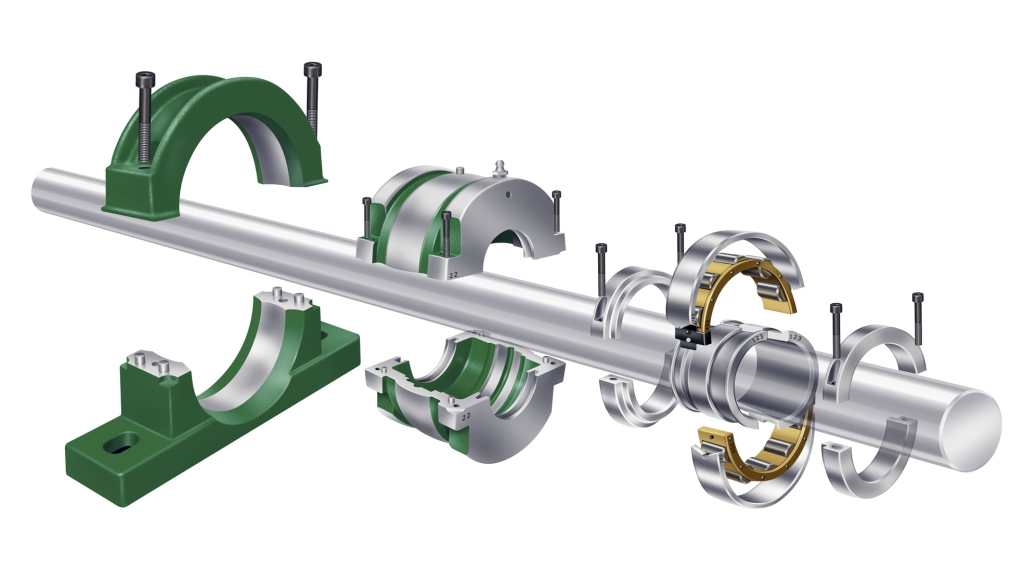
For instrument bearings, certain special considerations should be emphasized:
- Heavy press fits should be avoided.
- Accuracy of mounting surfaces should be equal to accuracy of mating bearing surface.
- Misalignment for low torque and running accuracy should not exceed 1/4°. Loading across the bearing during assembly should be avoided.
Axial positioning: Accurate axial positioning of the shaft relative to the housing requires shoulders, snap rings, or bearing flanges.
Shaft and housing shoulders: Diameter of a shaft or housing shoulder must be sufficient to ensure solid seating and support for applied thrust loads, yet small enough to avoid interference with other parts of the bearing. Most manufacturers provide recommended shoulder dimensions for each bearing size. Fit accuracy between shoulder and mounting diameter should be as good as bearing accuracy.
The corner between the shoulder and mounting diameter should be undercut because undercutting provides a more accurate machining of the shoulder surface. However, a radius is permissible if proper clearance is allowed.
Retaining rings: Certain cautions must be observed with this method:
- Recommendations as to the groove dimensions should be followed.
- Locating grooves machined into the shaft or housing must be controlled for squareness of groove face to bearing mounting diameter. Recommended value is 0.0002-in. TIR max.
- Parallelism of the faces of the ring should be held to 0.0002-in. TIR max.
- Lug dimensions should be checked to ensure there is no interference with the bearing. (Extended inner-ring bearings may offer an advantagehere.)
- Avoid a snap ring that locates directly on the shaft or housing diameter (no groove) if heavy thrust loads are involved.
Flanges: Squareness of face-to-bore of the housing is critical and should be maintained to within 0.0003-in. TIR. Corners may be broken or left sharp because the flange is undercut and flush seating is ensured.
Axial adjustment: Removal of excess bearing end play, when required, may involve preloading of the bearings. However, the most common requirement is to establish an allowable range of end play under a given reversing thrust load.
Shims: Best material is stainless steel. Brass shims can also be used; however, they wear more easily and produce abrasive particles that could contaminate the bearing. Shims, particularly brass or other soft materials, should be used only against the nonrotating ring.
Spring washers: Belleville and wave washers are the two most common types used. The washer should exert a very light load on the bearings. If extreme rigidity under external load is required, preloaded bearings should be used.
The use of a spring washer usually involves a loose fit between the bearing ring and its mounting surface. Therefore, the washer should apply its force against the nonrotating ring.
Threads: Generally, threads are not recommended to remove end play. They are too easily overtightened and can cause brinelling in the bearings.
If threads must be used, the bearings should be locked against a solid shoulder or spacer. It is important to achieve a solid locking force without overloading the bearing rings. A Class 2 fit is normally recommended because it provides for slight misalignment of the nut, enabling the nut face to be flush with the bearing. The nut-face squareness to the thread pitch circle should be held to 0.0005-in. max wherever possible.
Bearing fits: Extreme fits, whether loose or tight, are not recommended. The effect of press fits on contact angle or radial play must be considered. As a rule of thumb, mounted radial play (and hence contact angle) will be reduced by approximately 75% of the press fit. This is important where precise control on deflection rates is required or where low-radial-play bearings are used.
Size tolerance of the shaft and housing should be equal to those of the bearing bore and OD. Roundness and taper should be held to one-half of size tolerance. Surface finish should be held as close as possible.
Extreme fits will depend upon tolerances on the bearings, shaft, and housing. Upon request, the bearing manufacturer will code the bearing bores and OD into increments within the size tolerance. These increments are normally 0.0001 in., but can be supplied as low as 0.00005 in.
When operating at a temperature considerably different from room temperature, material expansion differences must be considered.
Adhesives offer several advantages in producing proper fits:
- End play can be removed by applying a light external thrust load during curing time.
- Extreme fits can be eliminated, since the adhesive will fill up any reasonable clearance.
- Rotational accuracy can be improved by driving the shaft at slow speed during cure time.
Disadvantages to using adhesives include:
- Certain adhesives are attacked by lubricants or solvents.
- To ensure a good bond, bearing surface, shaft, and housing must be thoroughly clean of oil and dirt.
- Adhesives may get into the bearing and cause damage.
- To en壯陽藥 sure a good bond without rotational inaccuracies, clearance should be held reasonably close. The tolerances on the shaft and housing should be of the same magnitude as standard-fits practice. Actual clearance depends upon the specific adhesive.
- Under vibration, some adhesives may break loose.
Machine Design